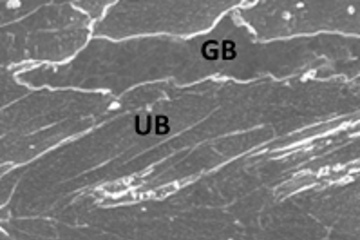All genres
81.
Journal Article
Coccospheres confer mechanical protection: New evidence for an old hypothesis. Acta Biomaterialia 42, pp. 258 - 264 (2016)
82.
Journal Article
Size and orientation dependent mechanical behavior of body-centered tetragonal Sn at 0.6 of the melting temperature. Acta Materialia 115, pp. 76 - 82 (2016)
83.
Journal Article
Effect of Microstructure on the Electro-Mechanical Behaviour of Cu Films on Polyimide. JOM-Journal of the Minerals Metals & Materials Society 68 (6), pp. 1640 - 1646 (2016)
84.
Journal Article
Are Mo2BC nanocrystalline coatings damage resistant? Insights from comparative tension experiments. Surface and Coatings Technology 289, pp. 213 - 218 (2016)
85.
Journal Article
Microscale Fracture Behavior of Single Crystal Silicon Beams at Elevated Temperatures. Nano Letters 16 (12), pp. 7597 - 7603 (2016)
86.
Journal Article
Electronic hybridisation implications for the damage-tolerance of thin film metallic glasses. Scientific Reports 6, 36556 , pp. 1 - 12 (2016)
87.
Journal Article
The effect of size on the strength of FCC metals at elevated temperatures: annealed copper. Philosophical Magazine 96 (32-34), pp. 3379 - 3395 (2016)
88.
Journal Article
Transition from shear to stress-assisted diffusion of copper–chromium nanolayered thin films at elevated temperatures. Acta Materialia 100, pp. 73 - 80 (2015)
89.
Journal Article
Influence of inclined twin boundaries on the deformation behavior of Cu micropillars. Materials Science and Engineering A: Structural Materials Properties Microstructure and Processing 642, pp. 65 - 70 (2015)
90.
Journal Article
In situ TEM microcompression of single and bicrystalline samples: insights and limitations. JOM-Journal of the Minerals Metals & Materials Society 67 (8), pp. 1704 - 1712 (2015)
91.
Journal Article
Deformation patterns in cross-sections of twisted bamboo-structured Au microwires. Acta Materialia 97, 12194, pp. 216 - 222 (2015)
92.
Journal Article
Adhesion measurement of a buried Cr interlayer on polyimide. Philosophical Magazine 95 (16-18), pp. 1982 - 1991 (2015)
93.
Journal Article
Micro-tension study of miniaturized Cu lines at variable temperatures. Acta Materialia 92, pp. 243 - 254 (2015)
94.
Journal Article
The influence of a brittle Cr interlayer on the deformation behavior of thin Cu films on flexible substrates: Experiment and model. Acta Materialia 89, pp. 278 - 289 (2015)
95.
Journal Article
Internal and external stresses: in situ TEM compression of Cu bicrystals containing a twin boundary. Scripta Materialia 100, pp. 94 - 97 (2015)
96.
Journal Article
Importance of dislocations pile-ups on the mechanical properties and the Bauschinger effect in micro cantilevers. Journal of Materials Research 30 (6), pp. 791 - 797 (2015)
97.
Journal Article
Can micro-scale fracture tests provide reliable fracture toughness values? A case study in silicon. Journal of Materials Research 30 (5), pp. 686 - 698 (2015)
98.
Journal Article
Insight into Emiliania huxleyi coccospheres by focused ion beam sectioning. Biogeosciences 12 (12), pp. 825 - 834 (2015)
99.
Journal Article
Measuring electro-mechanical properties of thin films on polymer substrates. Microelectronic Engineering 137 (1), pp. 96 - 100 (2015)
100.
Journal Article
On the reversibility of dislocation slip during small scale low cycle fatigue. Acta Materialia 94, pp. 69 - 77 (2015)











